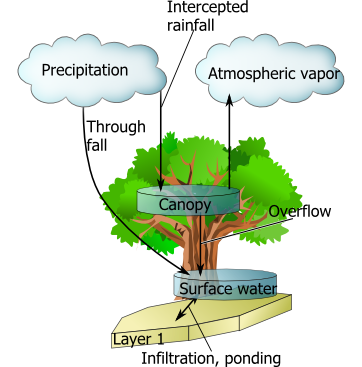|
2.0.0b10
catchment modelling framework
|
|
2.0.0b10
catchment modelling framework
|
For this tutorial we are going to setup a simplified version (1 Layer) of the 1D Model to observe the effect of above ground fluxes. The same model will be used in the next tutorial about snow. As an excercise, try to put this model together with the 1D Richards model with ET from the last tutorial.

Now we will extend our model with a canopy storage. In the figure on the right side, you can see how the canopy storage should be connected. The incoming rainfall, that has been routed before directly to the surface water is now split into intercepted rainfall, routed to the new canopy storage, and throughfall, routed still routed to the surface water. The fraction of intercepted rainfall is triggered by the variable canopy closure of the cell's Vegetation cell.vegetation.CanopyClosure. If this variable is 1, all rainfall is intercepted, and there is no throughfall. However, the predifined connection between rainfall and surface water is not aware of the canopy storage, hence both connections (Rainfall) need to be newly defined (see code below).
The second connection needed, is the overflow of the canopy. The leaves of the canopy can only store a limited volume of water, if this volume is reached, the canopy starts dripping. One of the best known models for the interception process is the model by Rutter et al. 1971. The overflow term of the model is implemented in cmf as RutterInterception. A special characteristik of the model is, that drippig stops together with rainfall. The capacity of the canopy storage is defined as the product of the leaf area index (cell.vegetation.LAI) and the capacity in mm per m2 leaf area cell.vegetation.CanopyCapacityPerLAI. To define which amount of water is directly routed to the surfaces as throughfall without being storaged in the canopy the canopy closure can be defined cell.vegetation.CanopyClosure. The default value of the canopy closure is 1, so there is no direct throughfall if it remains unchanged.
The third term of the Rutter model is the evaporation from the wet leaf surface. Currently only the Penman based CanopyStorageEvaporation and ShuttleworthWallace do this calculation.
The code below can be used to extend the setup code for the simple model above.